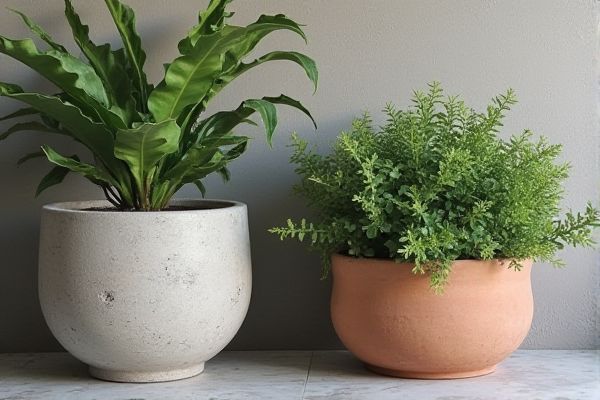
Concrete planters offer superior durability and insulation, making them ideal for maintaining consistent soil temperatures, while clay planters provide excellent breathability and a natural, classic aesthetic that enhances plant health through better aeration. Discover which planter best suits Your gardening needs by exploring the detailed comparison in the article below.
Table of Comparison
| Feature | Concrete Planter | Clay Planter |
|---|---|---|
| Material | Durable cement-based composite | Natural terracotta or baked clay |
| Weight | Heavy; provides stability | Light to moderate; easier to move |
| Porosity | Low porosity; retains moisture | Highly porous; improves drainage |
| Durability | Weather-resistant; long-lasting | Fragile; prone to cracking |
| Cost | Moderate to high | Low to moderate |
| Ideal Use | Large plants, outdoor settings | Small to medium plants, indoor & outdoor |
| Maintenance | Minimal; rinse as needed | Requires periodic sealing |
Introduction to Concrete and Clay Planters
Concrete planters offer durability and modern aesthetic appeal, making them ideal for outdoor use and large plants due to their heavy weight and resistance to weather. Clay planters, known for their porous nature, promote better aeration and moisture regulation for plant roots while providing a traditional, natural look. Your choice between concrete and clay planters depends on factors like design preferences, plant type, and environmental conditions.
Material Composition and Durability
Concrete planters are composed of cement, aggregates, and water, resulting in a dense, heavy structure known for exceptional durability and resistance to weather elements, making them ideal for outdoor use. Clay planters are made from natural earthen materials such as terracotta, offering breathability that supports root health but are more prone to cracking and weathering over time. The dense material composition of concrete planters provides superior longevity compared to the more porous and fragile nature of clay planters.
Weight and Portability Comparison
Concrete planters are significantly heavier than clay planters, often weighing several times more, which affects portability and placement flexibility. Clay planters are much lighter and easier to move, making them ideal for gardeners who frequently rearrange their plants or need seasonal mobility. The substantial weight of concrete planters provides stability against strong winds, but limits ease of transport compared to the lightweight and more portable clay options.
Aesthetic Appeal and Design Options
Concrete planters offer a modern, industrial aesthetic with sleek, minimalist designs that complement contemporary architecture, while clay planters provide a rustic, earthy charm with warm tones and traditional shapes. Concrete's versatility allows for customizable textures and colors, supporting bold, geometric patterns and large, statement pieces, whereas clay is limited to natural hues and classic, hand-crafted forms. Both materials suit different design preferences, with concrete excelling in urban and modern settings and clay enhancing natural, garden-inspired spaces.
Drainage and Moisture Retention Differences
Concrete planters offer superior moisture retention due to their dense, non-porous structure, which helps keep soil consistently damp. Clay planters provide excellent drainage as their porous walls allow water to evaporate quickly, reducing the risk of root rot. Your choice between concrete and clay planters impacts how well your plants manage water balance and root health.
Temperature Insulation Properties
Concrete planters offer superior temperature insulation properties compared to clay planters, helping to protect plant roots from extreme heat or cold. Clay planters tend to absorb and lose heat quickly, which can cause temperature fluctuations harmful to delicate plants. Choosing a concrete planter ensures your plants benefit from a more stable root environment, promoting healthier growth.
Environmental Impact and Sustainability
Concrete planters have a higher carbon footprint due to the energy-intensive manufacturing process of cement, contributing significantly to CO2 emissions. Clay planters are more environmentally friendly, made from natural materials that are biodegradable and often sourced locally, reducing transportation emissions. However, the durability of concrete planters means they require less frequent replacement, potentially lowering long-term environmental impact compared to fragile clay alternatives.
Cost Analysis: Concrete vs. Clay Planters
Concrete planters generally have a higher upfront cost than clay planters due to the labor-intensive manufacturing process and durability of materials. Clay planters are more affordable initially but may require replacement more often because they are prone to cracking and weather damage. Over time, concrete planters offer better value with lower maintenance costs and longer lifespan, making them a cost-effective choice for long-term use.
Best Uses and Recommended Plant Types
Concrete planters excel in durability and weight, making them ideal for outdoor use with larger plants such as shrubs, small trees, and succulents that require stable, insulated environments. Clay planters offer excellent breathability and moisture regulation, perfect for indoor herbs, flowers, and temperate plants that thrive in well-aerated soil. When selecting between concrete and clay, consider the plant's water needs and growth habits to ensure proper drainage and root health.
Final Verdict: Choosing the Right Planter
Concrete planters offer durability, insulating your plants against temperature fluctuations and retaining moisture effectively; clay planters, while more porous and lightweight, provide excellent breathability for root health. Your choice depends on whether you prioritize long-lasting strength and modern aesthetics or natural airflow and traditional appeal. Consider your plant species and environment to select the right planter for thriving growth.
 homyna.com
homyna.com